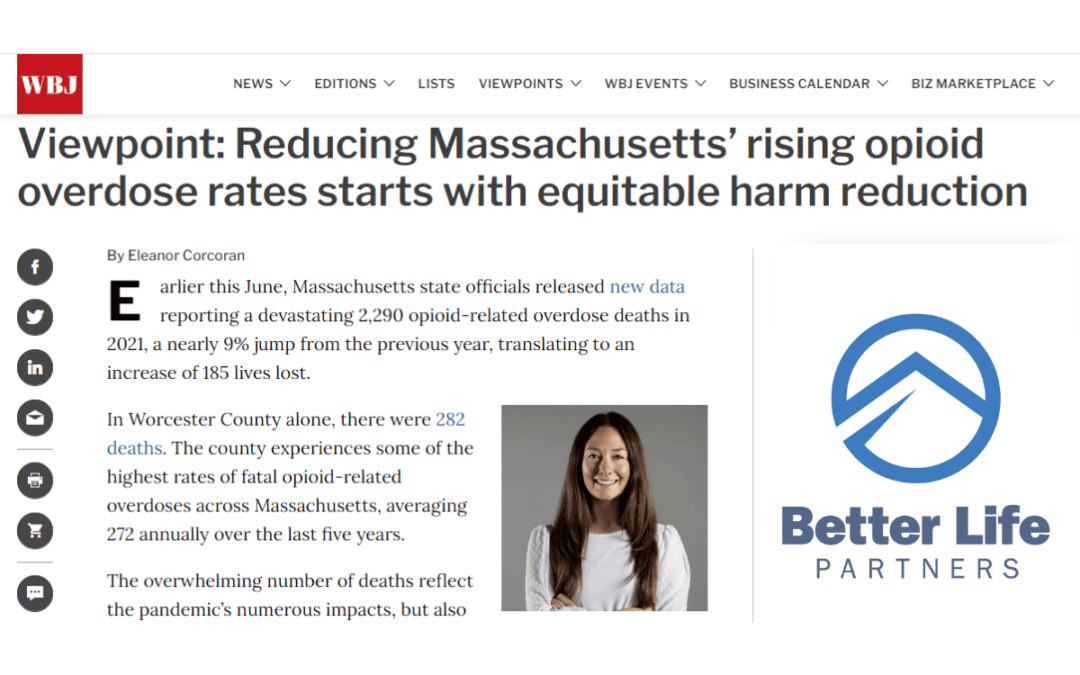*This article first ran in Worcester Business Journal and can be found here.
Earlier this June, Massachusetts state officials released new data reporting a devastating 2,290 opioid-related overdose deaths in 2021, a nearly 9% jump from the previous year, translating to an increase of 185 lives lost.
In Worcester County alone, there were 282 deaths. The county experiences some of the highest rates of fatal opioid-related overdoses across Massachusetts, averaging 272 annually over the last five years.
The overwhelming number of deaths reflect the pandemic’s numerous impacts, but also constitutes changing drug trends. While the rate of heroin in opioid-related overdoses dropped to 10% in 2021 and has been declining over the past several years, the rate of fentanyl and cocaine continue to rise. Since 2016, fentanyl’s presence has increased about 1% per quarter, and according to the state’s new data, the drug was present in approximately 93% of Massachusetts’ opioid overdoses last year.
With today’s shifting drug supply and increase in synthetics, the need for harm reduction measures like fentanyl testing strips (FTS) and NARCAN is more critical than ever. Harm reduction is grounded in principles that protect human life and improve public health. It consists of strategies that aim to prevent overdose and reduce the negative consequences associated with substance use by offering safer use options and meeting people where they’re at with services they want. These practices are proven to have a real impact on saving lives. FTS, for example, can detect the presence of fentanyl with up to 96% accuracy, and serve as a powerful intervention and informative measure for users – a measure that could be the difference between life or death.
Addressing disparities in treatment
Equally important to embracing harm reduction strategies is to proactively address racial and geographic inequities in quality of care. Black and Hispanic substance users continue to die at a much higher frequency than white substance users. Much of this is due to the fact that access to treatment is, and has historically always been, limited to these populations. As treatment providers, it’s incumbent upon us – and our greater society and systems – to continuously ask what can be done to address the inequities in substance use services.
For example, at Better Life Partners, we approach harm reduction with great urgency by offering same-day telehealth appointments to anyone who needs access to treatment, including medication-assisted recovery. Virtual services allow for care to be accessible, particularly in rural parts of the state like western Massachusetts where treatment options are sparse and for many people, inaccessible altogether.
Beyond accessibility, it’s important that recovery spaces are also a safe place for marginalized communities, including people of color, LGBTQ+ individuals and non-English speaking people. Creating designated groups for these communities, led by counselors and providers from similar backgrounds, is one way to create a more positive, engaging and trusting environment that can aid in the recovery journey.
Treating the whole person
While harm reduction is an effective point solution, addiction treatment doesn’t stop there. Successful recovery also requires the integration of medical, behavioral and social care due to the fact that addiction involves several factors that impact or influence substance use. Partnering with local organizations, such as community health centers, community mental health providers, and social workers, can help deliver more holistic care that touches all aspects of a person’s life – and do so right where people live and work, allowing for a more flexible, accessible, and achievable approach to long-lasting recovery.
Remaining steadfast in change
Above all, we must continue to remain steadfast as a society in our efforts to make radical changes when it comes to harm reduction and eliminating stigma around drug use. Every data point here represents a life lost, a family in pain, a human who, regardless of where they are in their recovery, deserves to be alive today. Harm reduction practices like NARCAN, fentanyl test strips, and same-day access to suboxone must be easily accessible to everyone and readily available if we sincerely want to save lives. Doing that takes a village and working together is the most effective way for us to reach everyone who wants and needs treatment.
To view the original article on Worcester Business Journal, go here.





